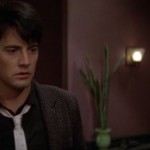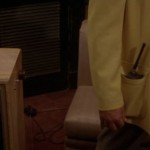Columns
-
The Blue Velvet Project, #142

Second #6674, 111:14 The seemingly insignificant, glimpsed, unremembered moments of a film revealed in the details of a random frame. In this case, Jeffrey’s watch, fleetingly illuminated as he retraces his steps back up to Dorothy’s apartment, in flight from the Well-Dressed Man. The importance of the watch may be the very fact of its unimportance—it has no significance in terms of the plot. And yet, it is a part of the film; it constitutes an element of Blue Velvet’s image-archive. The frames come from a compressed sequence made up of 17 shots that, in less than a minute of […]
-
The Blue Velvet Project, #141

Second #6627, 110:27 In one of Blue Velvet’s most unsettling moments, Jeffrey, on his way out of Dorothy’s carnaged apartment, sees the Well-Dressed Man coming towards the building in the night. Like some figure from a dream, he approaches, his police radio crackling. At this point, neither Jeffrey nor the audience knows, at least with any certainty, that the Well-Dressed Man is in fact Frank. In his essay “The Uncanny” (1919) Freud wrote that it is only this factor of involuntary repetition which surrounds with an uncanny atmosphere what would otherwise be innocent enough, and forces upon us the idea […]
-
The Queen of Versailles — A Hammer to Nail Review

As I left the screening of the documentary The Queen of Versailles, my immediate thought was, “This is why we can’t have nice things.” Director Lauren Greenfield has created a complicated, fascinating, and humbling film, perfectly calibrated to the zeitgeist. Election-year rhetoric aside, we remain in the ever-widening wake of the Great Recession, and Greenfield’s riches-to-rags story releases waves of conflicting emotion: pity, schadenfreude, guilt, empathy, disgust. With fortuitous—and perhaps shrewd—timing, her film captures an America in flux. The Queen of Versailles tells the story of David and Jackie Siegel, a billionaire couple who were building the largest house in America, a […]
-
The Blue Velvet Project, #140

“I’m gonna let them find you on their own,” Jeffrey quietly says to himself, invoking Frank, who will appear again in a few minutes. Turning away from the camera, his ear might actually hear the song on the soundtrack, Ketty Lester’s version of “Love Letters,” released as a single in 1961: [jwplayer mediaid=”48654″] The song was written in 1945 by Victor Young and Edward Heyman, and appeared in the film Love Letters, which starred Jennifer Jones and Joseph Cotten. Adapted by none other than Ayn Rand (“People should be able to build what they want to build, when they want […]
-
The Blue Velvet Project, #139

Second #6533, 108:53 1. Jeffrey’s reaction to the violence that has happened in Dorothy’s apartment shifts gradually in the moments that follow this shot from numbed horror to sorrow, as if what he sees before him (Dorothy’s husband and the Yellow Man, tortured and dead or dying) is in some sense the awful answer to his curiosity. 2. From Charles Musser’s The Emergence of Cinema: The American Screen to 1907: Sex and violence figured prominently in American motion pictures from the outset. In fact, such subjects were consistent with the individualized, peephole nature of the viewing experience: they showed amusements […]
-
The Blue Velvet Project, #138

Second #6486, 108:06 Inside Dorothy’s apartment Jeffrey surveys the carnage. The television set, its screen cracked. Detective Gordon, the Man in Yellow, somewhere in between dead and alive, and perhaps, at the outer edges of possibility, hooked up to the television. Lynch has talked about his desire to make a painting that “would really be able to move” as a motivation for making his first films, and during the apartment scene the screen does indeed become like a canvas, its objects staged and still, with occasional movement, some fevered dream of an automated wax-museum. Is Blue Velvet an avant-garde film? […]
-
Family Portrait in Black and White — A Hammer to Nail Review

(Family Portrait in Black and White is being distributed by First Pond Entertainment and opens theatrically at the AMC Empire 25 in New York City on July 13, 2012. It world premiered at the 2011 Sundance Film Festival. Visit the film’s official website to learn more.) The mere fact that I’m writing these words about Julia Ivanova’s Family Portrait in Black and White means something has gone right. That is to say, on the occasion of its theatrical release, no longer is this film one of those special little treats that bounced around the American festival circuit for over a […]
-
The Blue Velvet Project, #137

Second #6439, 107:19 Jeffrey is about to enter Dorothy’s apartment where he’ll find a hellish scene of Frank’s human butchery. The frame captures his vulnerability, his exposed back to the implied danger of the frame’s open space. The red light at the end of the hall, the sharp-edged shadow across the far door, the tar-pit black hallway floor, and the faint ringing noise on the soundtrack, like something deeply broken in the building itself, all conspire to create a feeling that verges on existential terror. In the pan and scan 1987 VHS version (the photo below is of the film […]
-
The Blue Velvet Project, #136

Second #6392, 106:32 If you’re of a certain age, you first saw Blue Velvet on VHS (Karl-Lorimar Video) in 1987, in its over-saturated, pan and scan version, which eliminated nearly 40% of the framed image (below). This is Sandy in her father’s home office, on the phone to the police station, trying desperately to reach her father to safeguard Jeffrey, who is on his way to Dorothy’s apartment. “We don’t know his whereabouts at this time,” the voice tells her from the other end of the line. In the VHS version, Sandy is psychedelic, illuminating the screen with her desire. […]
-
The Blue Velvet Project, #135

Second #6345, 105:45 Sandy, in her room, on the phone with Jeffrey after the naked, bruised, Dorothy has just revealed—in front of Jeffrey, Sandy, and Mrs. Williams—that Jeffrey “put his disease” in her. This frame comes from a shot that lasts just under one minute and that is so completely and dramatically sincere as to give lie to the notion that Blue Velvet is somehow a parody or an instance of postmodern Camp. Sandy’s question to herself when she gets off the phone with Jeffrey—“Where is my dream?”—offers a momentary gap in the film. For if most of the time […]










